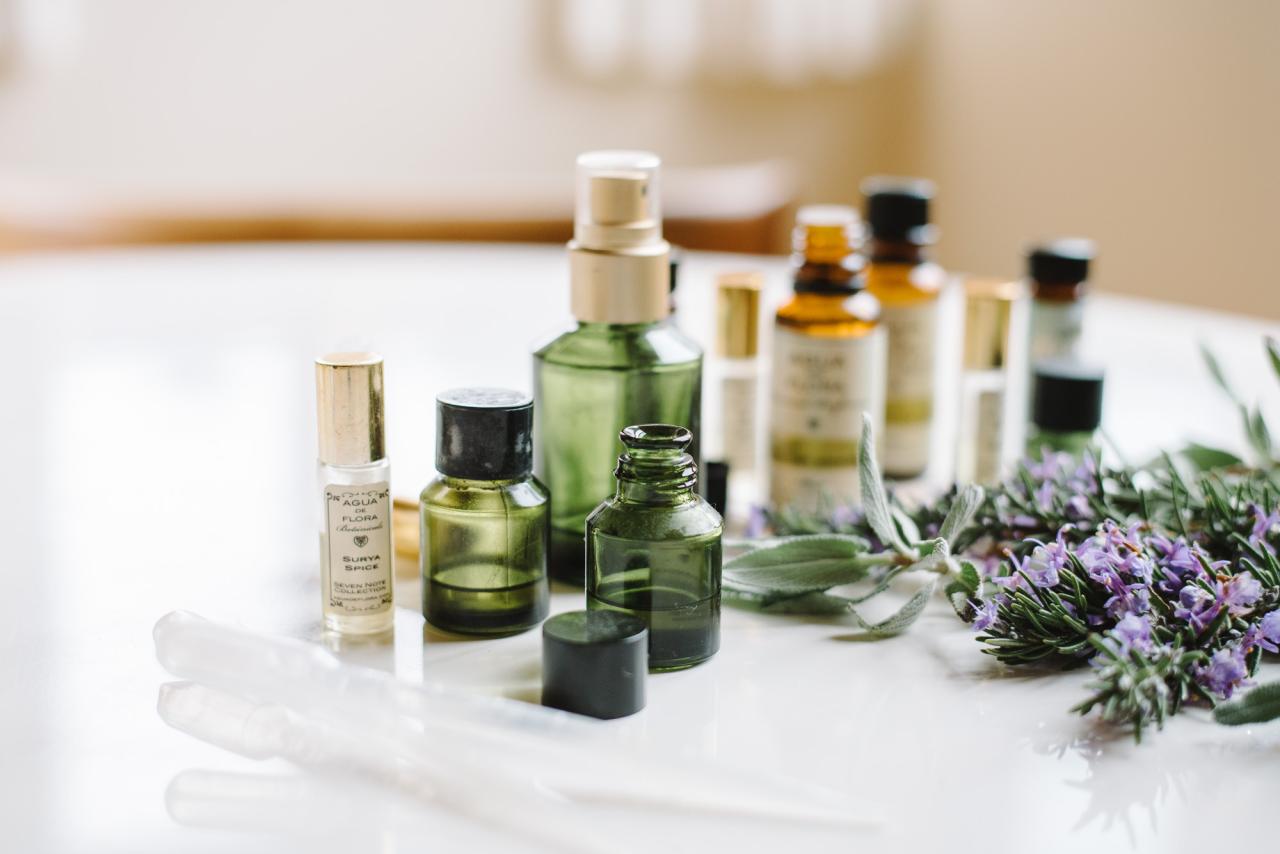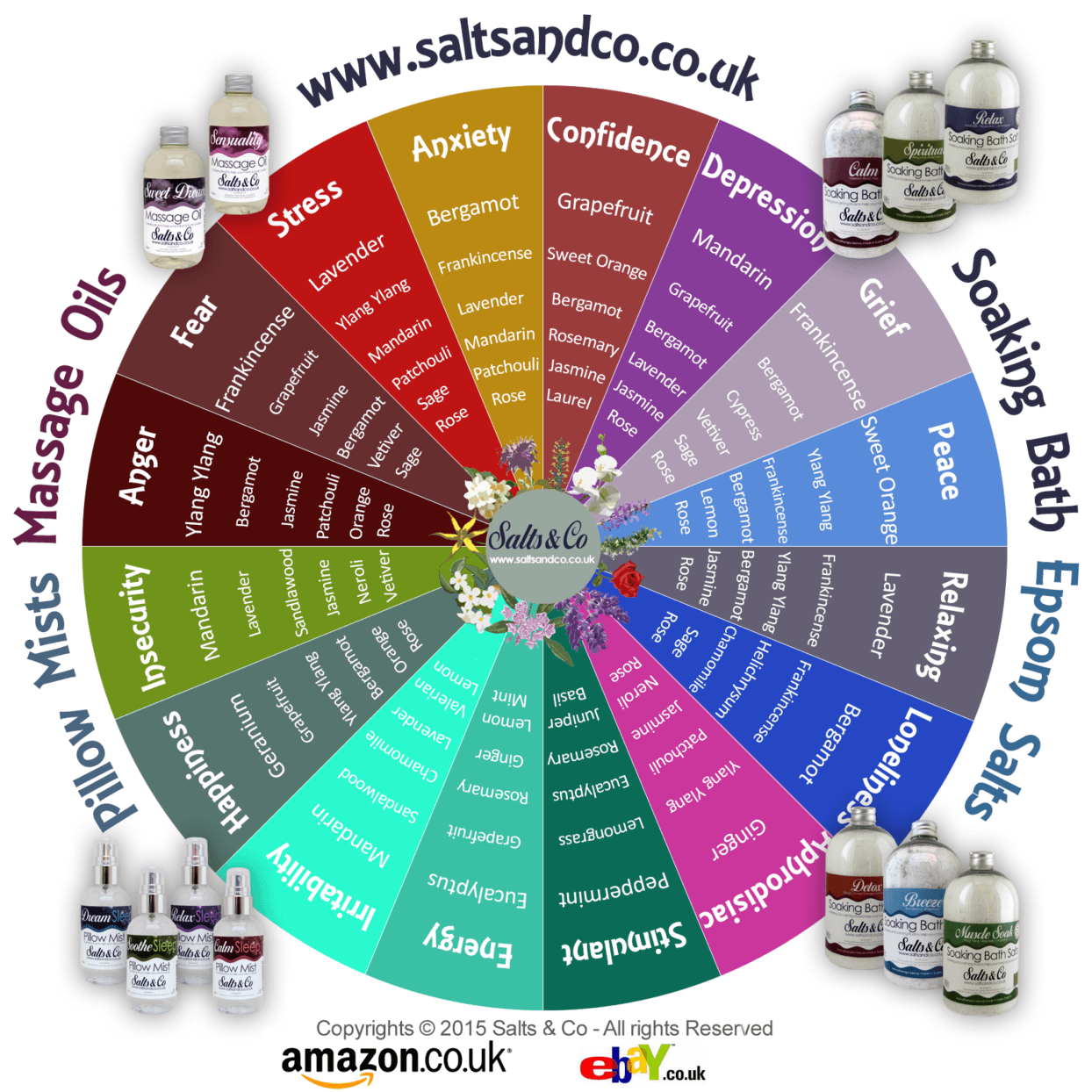Embark on a captivating journey into the realm of aromatherapy oils, where nature’s essence unveils its therapeutic wonders. This comprehensive guide will illuminate the properties and benefits of essential oils, empowering you to harness their healing potential for a healthier, more balanced life.
Delve into the intricate mechanisms of action, supported by scientific evidence, and discover how these aromatic compounds can address a myriad of health concerns. Prepare to be captivated as we unveil the secrets of essential oil selection, blending, and safe usage, empowering you to create personalized aromatherapy experiences that will transform your well-being.
Essential Oil Properties and Benefits
Essential oils are concentrated plant extracts that have been used for centuries for their therapeutic properties. They are made by distilling or pressing the leaves, flowers, or other parts of a plant to capture their volatile compounds. Essential oils are highly concentrated and can be used in a variety of ways, including aromatherapy, massage, and skincare.
Each essential oil has its own unique properties and benefits. Some of the most popular essential oils and their benefits include:
- Lavender oil:Relaxation, sleep, pain relief
- Peppermint oil:Energy boost, headache relief, nausea relief
- Eucalyptus oil:Decongestant, expectorant, antibacterial
- Tea tree oil:Antiseptic, antifungal, acne treatment
- Lemon oil:Mood boost, cleaning, air freshener
Mechanism of Action
Essential oils work by interacting with the body’s olfactory system and limbic system. The olfactory system is responsible for our sense of smell, while the limbic system is involved in emotions, memory, and behavior. When we inhale essential oils, the molecules travel through the nose and bind to receptors in the olfactory system.
These receptors then send signals to the limbic system, which can trigger a variety of physiological and psychological responses.
In addition to their effects on the olfactory system and limbic system, essential oils can also interact with the body’s other systems, including the immune system, the respiratory system, and the digestive system. This is why essential oils can be used to treat a wide range of health conditions, from anxiety and depression to colds and flu.
Scientific Evidence
There is a growing body of scientific evidence to support the use of essential oils for therapeutic purposes. For example, a study published in the journal Phytotherapy Researchfound that lavender oil was effective in reducing anxiety and improving sleep quality. Another study, published in the journal Aromatherapy Science, found that peppermint oil was effective in reducing headaches.
While more research is needed to fully understand the therapeutic benefits of essential oils, the existing evidence suggests that they can be a safe and effective way to improve your health and well-being.
Choosing the Right Essential Oils
Selecting the ideal essential oils for your needs is crucial to optimize their therapeutic benefits. Consider these factors when making your choice:
Desired Therapeutic Effect
Essential oils possess diverse therapeutic properties. Determine your primary purpose, whether it’s relaxation, stress relief, or pain management. Research the specific oils known for their desired effects.
Personal Preferences
Your personal preferences play a significant role in choosing essential oils. Explore different scents to find those that resonate with you. Consider factors like aroma, intensity, and compatibility with your body chemistry.
Safety Considerations
Essential oils can be potent and may have contraindications. Research the safety profile of each oil, especially if you have any health conditions or allergies. Consult a healthcare professional before using essential oils if you have any concerns.
Essential Oil Blends
Blending essential oils can enhance their therapeutic effects. Consider the following recommendations:
- Relaxation:Lavender, chamomile, bergamot
- Stress Relief:Peppermint, eucalyptus, rosemary
- Pain Management:Wintergreen, clove, ginger
Methods of Using Essential Oils
Essential oils can be utilized in various ways, each offering unique benefits and limitations. Here are the most common methods of using essential oils, along with safety considerations:
Aromatherapy
- Diffusion:Dispersing essential oils into the air using a diffuser or humidifier. This method creates an aromatic atmosphere, promoting relaxation, improving mood, and purifying the air.
- Inhalation:Directly inhaling essential oils from a bottle or diffuser. This is an effective way to experience their immediate effects, such as clearing congestion or reducing stress.
Topical Application
- Massage:Diluting essential oils in a carrier oil (e.g., jojoba, almond) and massaging them into the skin. This allows for localized absorption, promoting muscle relaxation, pain relief, and skin health.
- Bathing:Adding a few drops of essential oils to a warm bath can create a relaxing and rejuvenating experience. It promotes skin hydration, relieves muscle tension, and improves sleep quality.
- Compress:Applying a warm or cold compress infused with essential oils to a specific area of the body. This method is beneficial for reducing inflammation, soothing pain, and promoting healing.
Internal Consumption
- Ingestion:Consuming essential oils by adding them to food or beverages. This method should only be done under the guidance of a qualified healthcare professional, as certain essential oils can be toxic if ingested.
Safety Considerations:
- Always dilute essential oils in a carrier oil before applying them to the skin.
- Do not ingest essential oils unless specifically directed by a healthcare professional.
- Some essential oils may cause skin irritation or allergic reactions. Test a small area of skin before using them more widely.
- Keep essential oils away from children and pets.
- Store essential oils in a cool, dark place away from direct sunlight.
Safety and Precautions

Essential oils are powerful natural remedies, but they must be used safely and responsibly. Failure to do so can lead to potential risks and contraindications.
Essential oils are highly concentrated, so it’s crucial to dilute them properly before applying them to the skin. Undiluted oils can cause irritation, burns, and allergic reactions. Always follow the recommended dilution ratios provided by the manufacturer or a qualified healthcare professional.
Storage and Handling
- Store essential oils in a cool, dark place away from direct sunlight.
- Keep oils out of reach of children and pets.
- Use amber or cobalt blue glass bottles to preserve the oils’ integrity.
- Never ingest essential oils unless under the direct supervision of a qualified healthcare professional.
Disposal
- Dispose of essential oils by diluting them in water or a carrier oil and pouring them down the drain.
- Never dispose of essential oils directly into the environment.
- Follow local regulations for the disposal of hazardous materials.
DIY Essential Oil Blends
Creating your own essential oil blends allows you to customize therapeutic experiences and target specific needs. By combining different oils, you can enhance their benefits and create unique scents.
When blending oils, consider the following:
- Base oils:These oils, such as coconut or jojoba, dilute the blend and make it safe for topical use.
- Middle notes:These oils provide the heart of the blend, adding depth and complexity.
- Top notes:These oils evaporate quickly, creating the initial impression of the blend.
Relaxation Blend
- 3 drops lavender oil
- 2 drops chamomile oil
- 1 drop bergamot oil
This blend promotes relaxation and sleep. Diffuse it in your bedroom or apply it topically to the soles of your feet before bed.
Energy Boost Blend
- 4 drops peppermint oil
- 3 drops rosemary oil
- 2 drops lemon oil
This blend provides an energy boost and improves focus. Diffuse it in your workspace or apply it topically to your temples.
Pain Relief Blend
- 5 drops eucalyptus oil
- 3 drops peppermint oil
- 2 drops ginger oil
This blend alleviates muscle and joint pain. Apply it topically to the affected area or diffuse it in a warm bath.
Antibacterial Blend
- 5 drops tea tree oil
- 3 drops oregano oil
- 2 drops thyme oil
This blend fights bacteria and infections. Diffuse it in your home or apply it topically to wounds or blemishes.
Summary

As we conclude our exploration of aromatherapy oils, let us remember the profound power they hold to enhance our physical, emotional, and spiritual health. By embracing the wisdom of nature’s scents, we can unlock a world of therapeutic possibilities, fostering a deep connection between mind, body, and soul.